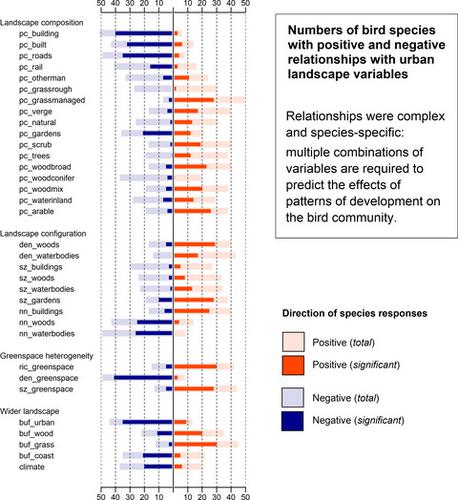当前位置:
X-MOL 学术
›
J. Appl. Ecol.
›
论文详情
Our official English website, www.x-mol.net, welcomes your feedback! (Note: you will need to create a separate account there.)
Evaluating the potential for bird‐habitat models to support biodiversity‐friendly urban planning
Journal of Applied Ecology ( IF 5.7 ) Pub Date : 2020-06-20 , DOI: 10.1111/1365-2664.13703 Kate E. Plummer 1, 2 , Simon Gillings 1 , Gavin M. Siriwardena 1
中文翻译:

评估鸟类栖息地模型支持生物多样性友好型城市规划的潜力
更新日期:2020-06-20
Journal of Applied Ecology ( IF 5.7 ) Pub Date : 2020-06-20 , DOI: 10.1111/1365-2664.13703 Kate E. Plummer 1, 2 , Simon Gillings 1 , Gavin M. Siriwardena 1
Affiliation

|
- Urban expansion poses a major threat to wildlife populations. Biodiversity‐friendly urban landscapes could deliver benefits for both wildlife and people, by incorporating conservation and ecosystem services objectives. Well‐designed urban developments could also soften the ecological impacts of urbanization. However, delivering urban landscapes that integrate biodiversity requirements effectively remains challenging.
- Ecological models, designed to predict wildlife population responses to alternative urban designs, could prove effective in supporting the creation of biodiversity‐friendly urban landscapes. Here, we combine national‐scale bird abundance data with high resolution, spatially explicit habitat data to characterize relationships between bird densities and urban landscape form in Britain. From these analyses and cross validation, we evaluate the potential for well‐parameterized, species‐specific models to be used to predict bird densities in novel or modified urban areas.
- Our analyses indicate that responses of bird abundance to urban habitat are species‐specific and complex, with few variables consistently affecting a large proportion of species. However, contiguous areas of greenspace within urban sites are preferential for accommodating breeding birds, compared to a more fragmented arrangement of multiple, small greenspace patches. In combination, the bird‐habitat relationships identified could successfully predict observed variation in abundance for most bird species considered.
- Further evaluation of habitat descriptor variables, spatial scales of species' habitat use and analytical modelling approaches may be needed to improve the predictive ability of bird‐habitat models for certain species, particularly waterbirds and those observed less frequently in urban areas.
- Synthesis and applications. We modelled breeding bird abundance in built‐up areas with respect to the characteristics and contexts of urban environments. While most variables were important for multiple species, responses overall were species‐specific, so simple assemblage metrics, like diversity, will not describe the variation in bird communities well. However, the results illustrate the potential of an evidence‐based, spatially explicit evaluation of urban development impacts on biodiversity, by predicting the consequences for bird numbers. Subject to verification of predictive ability, practitioners can apply the models to compare, for example, land‐sparing and sharing within developments, or to quantify the biodiversity requirements for effective offsetting. This would be facilitated by incorporation into an online tool allowing user‐determined input scenarios.
中文翻译:

评估鸟类栖息地模型支持生物多样性友好型城市规划的潜力
- 城市扩张对野生动植物种群构成了重大威胁。通过纳入保护和生态系统服务目标,有利于生物多样性的城市景观可为野生生物和人类带来益处。精心设计的城市发展也可以减轻城市化对生态的影响。但是,提供有效整合生物多样性要求的城市景观仍然是一项挑战。
- 旨在预测野生动植物种群对替代城市设计的反应的生态模型可以证明在支持创建对生物多样性友好的城市景观方面是有效的。在这里,我们将国家规模的鸟类丰度数据与高分辨率的,在空间上明确的栖息地数据相结合,以表征鸟类密度与英国城市景观形态之间的关系。通过这些分析和交叉验证,我们评估了参数合理的物种特定模型用于预测新型或改造城市地区鸟类密度的潜力。
- 我们的分析表明,鸟类丰富度对城市栖息地的响应是特定于物种的且复杂的,几乎没有变量持续影响很大比例的物种。但是,与多个小型绿地块的零散排列相比,城市场地内绿地的连续区域更适合容纳繁殖鸟类。结合起来,确定的鸟类与栖息地的关系可以成功地预测观察到的大多数鸟类物种的丰度变化。
- 可能需要进一步评估栖息地描述符变量,物种栖息地使用的空间尺度和分析建模方法,以提高鸟类栖息地模型对某些物种的预测能力,尤其是水鸟和那些在城市地区较少见到的鸟类。
- 综合与应用。我们根据城市环境的特征和环境对建成区的鸟类繁殖数量进行了建模。尽管大多数变量对多种物种都很重要,但总体上的响应是特定于物种的,因此简单的组合指标(如多样性)不能很好地描述鸟类群落的变化。但是,结果通过预测鸟类数量的后果,说明了对城市发展对生物多样性影响进行基于证据的空间明确评估的潜力。在验证预测能力的前提下,从业人员可以应用这些模型进行比较,例如,在开发项目中进行土地保护和共享,或者量化有效抵消所需的生物多样性需求。通过将其合并到允许用户确定输入场景的在线工具中,将有助于实现这一目标。



























 京公网安备 11010802027423号
京公网安备 11010802027423号